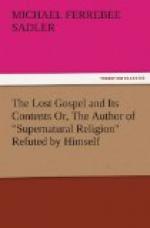Here, then, is a Gospel, the Gospel to the Hebrews, which not only contained, as the author has shown, a harmony of the histories in SS. Matthew and Luke, so far, at least, as the Birth and Death of Christ are concerned, but also such a full and consecutive report of the moral teaching of Christ, that it may not unfitly be described as “a series of passages in close sequence to each other,” collected “with singular care” “from distant and scattered portions of these Gospels.” How, we ask, could such a Gospel have perished utterly? A Gospel, which, besides containing records of the historical and supernatural much fuller than any one of the surviving Gospels, contained also a sort of Sermon on the Mount, amalgamating in one whole the moral teaching of our Lord, ought surely (if it ever was in existence) to have won its place in the canon.
SECTION VIII.
The principal witness.—His testimony to st. John.
We have now to consider the citations (or supposed citations) of Justin from the fourth Gospel. These, as I have mentioned, are treated by the author of “Supernatural Religion” separately at the conclusion of his work.
Whatever internal coincidences there are between the contents of St. John and those of the Synoptics, the external differences are exceedingly striking, and it is not at all to my present purpose to keep this fact out of sight. The plan of St. John’s Gospel is different, the style is different, the subjects of the discourses, the scene of action, the incidents, and (with one exception) the miracles, all are different.
Now this will greatly facilitate the investigation of the question as to whether any author had St. John before him when he wrote. There may be some uncertainty with respect to the quotations from the Synoptics, as to whether an early writer quotes one or other, or derives what he cites from some earlier source, as for instance from one of St. Luke’s [Greek: polloi].
But it cannot be so with St. John. A quotation of, or reference to, any words of any discourse of our Lord, or an account of any transaction as reported by St. John, can be discerned in an instant. At least it can be at once seen that it cannot have been derived from the Synoptics, or from any supposed apocryphal or traditional sources from which the Synoptics derived their information.
The special object of this Gospel is the identification of the pre-existent nature of our Lord with the eternal Word, and following upon this, His relation to His Father on the one side, and to mankind on the other.
He is the only begotten of the Father, God being His own proper Father [Greek: idios], and so He is equal to the Father in nature (John v. 18), and yet, as being a Son, He is subordinate, so that He represents Himself throughout as sent by the Father to do His will and speak His words.




